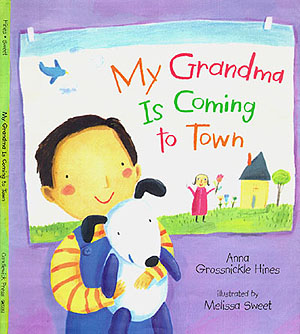|
Reviews:
This joyous story impressively invokes a toddler's love for his distant Grandma. They have a very special relationship carried out primarily by phone. When the little narrator was a baby, he says, his Grandma came to visit and taught him the pat-a-cake rhyme. Then he could only say "Patta patta, rolla rolla." Now they have a cherished ritual: "when Grandma calls on the phone, she still says, 'Patta patta'. 'Rolla rolla,' I say." He points out that though Grandma lives too far away to give him real kisses and hugs, "...she puts lots of X kisses and O hugs in her letters." So when Grandma writes that she is coming for a visit, he can hardly wait. When the day finally arrives, he is surprised to find that it feels so strange. She looks like grandma, but different, and though she offers a "Patta patta," she sounds just a little wrong and too shy of her, he can't bring himself to respond. The boy soon figures out what he needs to smooth the transition and with Grandma sitting right next to him, he pretends to call her on the phone. It isn't long before they are thoroughly enjoying the visit, this time with real hugs and kisses. For so many children whose favorite family members live far away, Hines handles this issue with style, never forgetting to give kids credit for solving problems. Kirkus, March 2003
In Hines's sympathetic and developmentally astute story, young Albert, the narrator, discovers that a grandma in person trumps a long-distance grandma any day. Albert hasn't seen his "Pat-a-Cake Grandma" since his baby days, but he cherishes his memories of playing the game with her ("I could only say, 'Patta patta, rolla rolla'") and when she calls, they have a special "telephone game" (she says, "Patta patta" and he answers, "Rolla rolla". But when Grandma shows up in person on his doorstep, Albert needs time to adjust: "She sounded like my Pat-a-Cake Grandma, only closer. I wanted to say 'Rolla rolla', but my mouth couldn't. I was too shy of this grandma." Sweet's cheery acrylics and pencil illustrations convey Albert's conflicting emotions with aplomb. He covers his eyes in a futile attempt to disappear, then hides behind his stuffed dog. Author and artist do not belabor Albert's struggle to reconcile Grandma-the-idea vs. Grandma-in-the-flesh, nor do they bring in the grown-ups to intervene. Instead they wisely allow Albert to overcome his reticence all by himself: he calls Grandma on his toy phone (Grandma answers on a nearby banana) and joyfully confirms that the wonderful voice he hears belongs to the nice lady in the chair next to him, "My real Pat-a-Cake Grandma." Albert's savvy self-sufficiency should leave youngsters beaming with approval--and perhaps they will discover its application in their own lives. Publishers Weekly, February 2003
Hines is right on the mark with this sweet story about a young boy who is looking forward to a visit from his out-of-town grandma. Although Albert hasn't actually seen his grandma since she visited when he was a baby, he frequently talks to her on the phone, always playing their special pat-a-cake game. But when she arrives this time, Albert is overcome with shyness and hides behind his stuffed dog. His parents urge but never force him to give Grandma kisses, and wise Grandma sits back and lets Albert take the lead. Soon Albert "calls" Grandma on his toy phone, and they play their special game, slowly moving closer as she reads from a book she once sent him as a present. Sweet's gentle, childlike illustrations, rendered in acrylic and colored pencil, do a great job of conveying the story from Albert's egocentric point of view, and Albert's first-person telling, as well as the actions of grown-ups, will really strike a chord with kids--and not only the shy ones. ALA Booklist
Albert has not seen his grandmother since he was a baby. However, they have spoken on the phone often and formed a special bond. One day, he receives a letter from her, telling him that she will soon visit. The boy is very excited until she actually arrives, and then he is shy. He does not remember her and is too apprehensive to even look at her. After giving him a little time to warm up. Grandma helps him overcome his fears by reciting the familiar greeting that she always shares with him on the phone. Done in acrylic and colored pencil, the illustrations are filled with vibrant colors balanced by backgrounds in paler hues. The simple and uncluttered style of the artwork emphasizes the relationship between the two main characters and the family's welcoming prep art ions. In today's mobile society, many children do not live close enough to see their grandparents on a regular basis, and this book does an excellent job of addressing that issue. School Library Journal, July 2003
|
